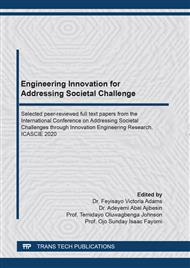[1]
A. Burns, R. Gleadow, R. J. Cliff, A. Zacharias, T. Cavagnaro, Cassava: The Drought, War and Famine Crop in a Changing World, Sustainability 2010. 2, 3572-3607.
DOI: 10.3390/su2113572
Google Scholar
[2]
S. Idris, S. Rosnah, M.Z.M. Nor, M.N. Mokhtar, S.S, Abdul Gani, Physicochemical composition of different parts of cassava(Manihot esculenta Crantz) plant, Food Research (Suppl.1) 2019, 78-84.
DOI: 10.26656/fr.2017.4(s1).s33
Google Scholar
[3]
S. Rahman and B.O Awerije, Exploring the potential of cassava in promoting agricultural growth in Nigeria, J AGR RURAL DEV TROP, 2016, 117(1)149-163.
Google Scholar
[4]
E. Alisson, Cassava flour can be a partial substitute for wheat flour in bread. Agencia FAPESP, 2017http://agencia.fapesp.br/cassava-flour-can-be-a-partial-substitute-for-wheat-flour-in-bread/26423/.
DOI: 10.4314/jorind.v8i2.66849
Google Scholar
[5]
M.R. Lee, B.G. Swanson B.K. Baik, Influence of amylose content on properties of wheat starch and breadmaking quality of starch and gluten blends. CerealChem., 78:701-706.
DOI: 10.1094/cchem.2001.78.6.701
Google Scholar
[6]
K. Falade, J. Akingbala, Utilization of cassava for food. Food Reviews International, 2010 27(1), 51-83.
DOI: 10.1080/87559129.2010.518296
Google Scholar
[7]
E. Eriksson, K. Koch, C. Tortoe, P.T, Akonor, C. Oduro-Yeboh, Evaluation of the physical and sensory characteristics of bread produced from three varieties of cassava and wheat composite flours, food and public health, 2014, 4(5), 214-22.
Google Scholar
[8]
F. Nweke The cassava transformation in Africa. A review of cassava in Africa with country case studies on Nigeria, Ghana, the United Republic of Tanzania, Uganda and Benin. FAO, Rome 2005. Available http://www.fao.org/docrep/009/a0154e/A0154E02.htm#ch1[2012-10-22].
Google Scholar
[9]
Global cassava market study - business opportunities for the use of cassava proceedings of the validation forum on the global cassava development strategy. Food and Agricultural Organization of the United Nations, 6(2004) Rome, https://fao.org/docrep/007/y5287e/y5287e00.html [2012-10-15].
Google Scholar
[10]
M.O. Iwe, N, Micheal, N.E, Madu, N.E Obasi, G.I, Onwuka, T.U, Nwabueze, J.O, Onuh, V.U, Asumugha, Production and Evaluation of Bread Made from High Quality Cassava Flour (HQCF) and Wheat Flour Blends, 2017 Agrotechnology 6:166.
DOI: 10.4172/2168-9881.1000166
Google Scholar
[11]
F.T. Denton, I.I. Azuogu, M.K. Ukoli, M.O. Adewoye, V.O. Olomo, B.A. Achem, Cassava based recipes for house-hold utilization and income generation,2003, RTEP-AIDU, Abuja, 40.
Google Scholar
[12]
A.O.A.C (2000) Official method of analysis seventeen ed., Association of Official Analysis Chemist (AOAC) International, Gathershurg, M.D.
Google Scholar
[13]
G.I. Onwuka, Food Analysis and Instrumentation; 2005. Theory and Practice first ed., Naphthali prints, Surulere Lagos, Nigeria. 219- 230.
Google Scholar
[14]
U.J. Ukpabi, C. Ndimele, Evaluation of the quantity of Garri produced in Imo State. Nig. Food J.8(1990),105-110.
Google Scholar
[15]
M. Carvea- Bencini, Functional properties of drum dried chickpeas (Cicerarietinum)flour 1986, Int. J. Food, 51, 1518.
Google Scholar
[16]
A.I. Ihekoronye, P.O. Ngoddy, Integrated Food Science and Technology for the Tropics, Macmillan Publ. London. 1985 pp.283-289.
Google Scholar
[17]
N.T. Dziedzoave, A.B. Abass, W.K.A. Amoa-Awua, M. Sablah, Quality management manual for production of high quality cassava flour. International Institute of Tropical Agriculture (2006).
Google Scholar
[18]
N.T. Dziedzoave, A.J. Graffham, E.O. Boateng, Training manual for the production of high quality cassava flour. Food Research Institute (FRI), Accra, Ghana (2003).
Google Scholar
[19]
U. Meier, A note on the power of Fisher's least significant difference procedure, Pharmaceutical Statistics. 2006, 5(4): 253-63.
Google Scholar
[20]
S.J. Tian, J.E. Rickard, J.M.V. Blanshard, Physicochemical of sweet potato starch. J. Sci. Food Agric.57(1991):459-491.
DOI: 10.1002/jsfa.2740570402
Google Scholar
[21]
G. Eggleston, P.E. Omoaka, Arowshegbe, A.U, Flour, starch and composite bread making quality of various cassava clones. J. Sci. of Food Agric, 62(1993), 49-59.
DOI: 10.1002/jsfa.2740620107
Google Scholar
[22]
M.C. Iheagwara. Effects of tuber sections and processing conditions on the physicochemical properties of sweet potato (Ipomoea batatas L (Lam)) flour.M.Sc thesis Dept. Food Sci. and Tech, Federal University of Technology, Owerri, Imo State, Nigeria. (2006).
DOI: 10.1093/fqsafe/fyz023
Google Scholar
[23]
C.K. Ocloo, Functional and physicochemical characteristics of starch obtained from Gamma- irradiated sweet potato (Ipomea batatas L.). J.Agric Tech. 2011, 1(7): 116-122.
Google Scholar
[24]
F.B. Apea-Bah, I. Oduro, W.O. Ellis, O. Safo-Kantanka, Factor analysis and age at harvest effect on the quality of flour from four cassava varieties. World Journal of Dairy & Food Sciences, 6(2011). 43-54.
Google Scholar
[25]
C. Lagnika, P.A.F. Houssou, V. Dansou, A.B. Hotegni, A.O. Amoussa, F.Y. Kpotouhedo, S.A. Dokbo, L. Lagnika, Phsico-functional and sensory properties of flour and bread made from composite wheat-cassava, Pakistan J Nutr. 2019 18 (6): 538-547.
DOI: 10.3923/pjn.2019.538.547
Google Scholar
[26]
S. Jensen, L.H. Skibsted, U. Kidmose, A.K. Thybo, Addition of cassava flours in bread-making: Sensory and texturel evaluation. LWT-FoodSci.Technol., 2015 60: 292-299.
DOI: 10.1016/j.lwt.2014.08.037
Google Scholar
[27]
K. Falade, J. Akingbala, Improved nutrition and national development through the utilization of cassava in baked foods In Robertson, G.L. & Lupien, J.R. (Eds.), Using Food Science and Technology to Improve Nutrition and Promote National Development. International Union of Food Science & Technology(2008).
Google Scholar


